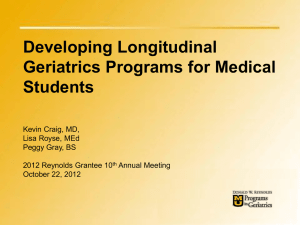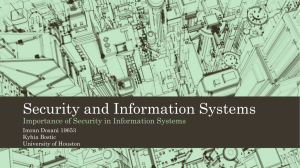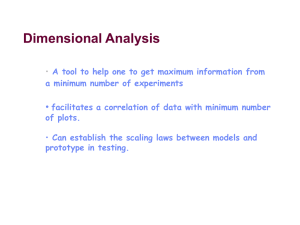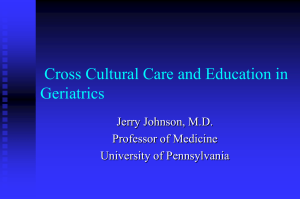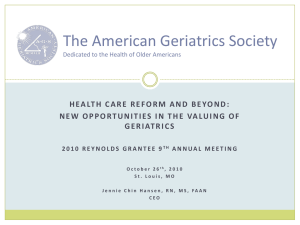Image Atlas of Aging - University of Massachusetts Medical School
advertisement
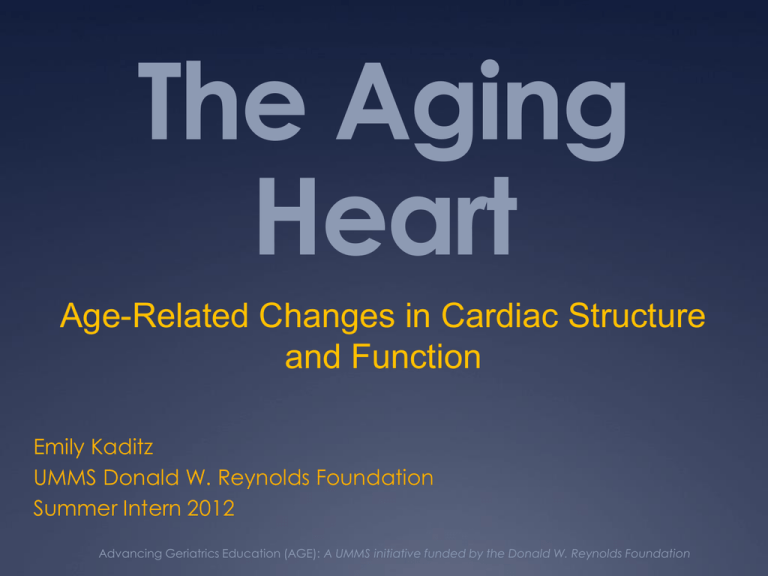
The Aging Heart Age-Related Changes in Cardiac Structure and Function Emily Kaditz UMMS Donald W. Reynolds Foundation Summer Intern 2012 Advancing Geriatrics Education (AGE): A UMMS initiative funded by the Donald W. Reynolds Foundation Why Care About Pictures of the Normal Aging Process? Images of Normal vs. Pathology Text on Normal vs. Aged Images of Aged Almost no resources available Advancing Geriatrics Education (AGE): A UMMS initiative funded by the Donald W. Reynolds Foundation Why Should You Care? The % of people 65 years and older is projected to rise from 13% to 20% between 2010 and 2030. Older US Population by Age: 1950-2050 Percent 60+, Percent 65+, and 85+ 30% % 60+ % 65+ Regardless of the field of medicine you choose, you will treat more patients who are 65 years or older than any previous generation of physicians. % 85+ 25% 20% 15% 10% 5% 0% 1950 1960 1970 1980 1990 2000 2010 2020 2030 2040 2050 Advancing Geriatrics Education (AGE): A UMMS initiative funded by the Donald W. Reynolds Foundation Aging ≠ Disease And disease is not inevitable with aging However, the chance of developing some diseases increases with age… This is a function of HOMEOSTENOSIS. Normal young Normal aged PASSAGE OF TIME Disease (sometimes) Advancing Geriatrics Education (AGE): A UMMS initiative funded by the Donald W. Reynolds Foundation Homeostasis vs. Homeostenosis Homeostasis = the process through which the body maintains internal equilibrium. With aging, more physiologic reserves are needed to maintain homeostasis when the body is not at rest. Homeostenosis = the normal decline in the body’s functional reserves. With aging, homeostenosis increases the vulnerability of organs to certain disease states, but a homeostenotic organ is not necessarily diseased. Advancing Geriatrics Education (AGE): A UMMS initiative funded by the Donald W. Reynolds Foundation Homeostenosis Physiologic reserves allow us to maintain homeostasis in the presence of environmental, emotional, or physiological stress. + HOMEOSTASIS STENOSIS = HOMEOSTENOSIS With homeostenosis, an insult that may be withstood in a younger person pushes the elderly beyond their functional capacity, causing decompensation, disease, or death. Advancing Geriatrics Education (AGE): A UMMS initiative funded by the Donald W. Reynolds Foundation Homeostenosis • Exertion requires the body to engage its physiologic reserves. • The homeostasis line can be thought of as the state of the heart at rest. • Think of the red arrow as representing the physiologic reserve required to carry 20 lbs. up a flight of stairs. You Advancing Geriatrics Education (AGE): A UMMS initiative funded by the Donald W. Reynolds Foundation Consider a Case… A normal 78 year old woman comes in for her regular check-up. She reports feeling fine at rest, and is able to do most of her activities of daily living (ADL) without any problems. Recently, however, she has noticed that when carrying things up stairs in her home she becomes short of breath, and has even had to stop and rest if her load is too heavy. What is causing her shortness of breath? • It is normal for the capacity for physical exertion to decline with aging. • In the heart, normal aging brings about changes that contribute to this decreased tolerance for exertion. Advancing Geriatrics Education (AGE): A UMMS initiative funded by the Donald W. Reynolds Foundation Homeostenosis in the Aging Heart In other words, a homeostenotic heart is one that has undergone the normal aging process. Compared with a normal young heart, the aged heart has a decreased functional capacity, but is not diseased. Advancing Geriatrics Education (AGE): A UMMS initiative funded by the Donald W. Reynolds Foundation Homeostenosis: Visual Evidence While homeostenosis is a physiologic phenomenon, its anatomic basis can be seen on a gross and histological level. Let’s turn to consider this… Advancing Geriatrics Education (AGE): A UMMS initiative funded by the Donald W. Reynolds Foundation Quick Review: Heart Structure & Blood Flow Superior Inferior Advancing Geriatrics Education (AGE): A UMMS initiative funded by the Donald W. Reynolds Foundation Cardiac Homeostenosis: Changes with Normal Aging 1. Structural a. LV wall thickness, LV chamber size 2. Histologic/Cellular b. Aortic valve calcification c. Mitral annulus calcification 3. Molecular 4. Functional Advancing Geriatrics Education (AGE): A UMMS initiative funded by the Donald W. Reynolds Foundation Left Ventricular Structural Changes left ventricular (LV) wall thickness, LV chamber size Advancing Geriatrics Education (AGE): A UMMS initiative funded by the Donald W. Reynolds Foundation Valvular Changes Insert image Normal Aortic Valve image such as can be viewed via http://www.heart-valvesurgery.com/Images/normal-aorticvalve.jpg Insert image Normal Mitral Valve image such as can be viewed via http://dx.doi.org/10.1016/j.carrev.2009. 10.004 Normal mitral valve Normal aortic valve Leaflet calcification Insert image Annulus Calcification image such as can be viewed via http://www.heartvalve-surgery.com/Images/mitralvalve-calcification.jpg. Annulus calcification Advancing Geriatrics Education (AGE): A UMMS initiative funded by the Donald W. Reynolds Foundation Cardiac Homeostenosis: Changes with Normal Aging 1. Structural 2. Histologic/Cellular 3. Molecular 4. Functional a. # of cardiomyocytes b. ( apoptosis, necrosis) c. myocyte size (hypertrophy) d. lipid deposits e. lipofuscin deposition f. collagen deposition and fibrosis in myocardium g. Thickening of arterial intima Advancing Geriatrics Education (AGE): A UMMS initiative funded by the Donald W. Reynolds Foundation Myocyte #, Myocyte Size (Hypertrophy) Medium Power Low Power Normal Aged Normal High Power Note: Clear spaces between the muscle fibers are artifacts due to slide processing and are not present in living tissue, however there is a slight increase in inter-myocyte space in the aged heart. Aged Muscle fibers thicken Nuclei of hypertrophic myocytes are larger and darker Normal Aged Advancing Geriatrics Education (AGE): A UMMS initiative funded by the Donald W. Reynolds Foundation Lipid Deposits Lipofuscin Deposition Lipofuscin (black arrows) is a brownish “wear and tear” pigment that accumulates with age. The pigment is a product of lipid oxidation, and is a sign of free radical damage. UMMS CC License Guido Majno Collagen deposition/ fibrosis Advancing Geriatrics Education (AGE): A UMMS initiative funded by the Donald W. Reynolds Foundation Thickening of Arterial Intima UMMS CC License Guido Majno Normal UMMS CC License Guido Majno Aged Advancing Geriatrics Education (AGE): A UMMS initiative funded by the Donald W. Reynolds Foundation Cardiac Homeostenosis: Changes with Normal Aging 1. Structural 2. Histologic/Cellular 3. Molecular a. Altered Ca2+ handling b. β-adrenergic 4. Functional responsiveness Advancing Geriatrics Education (AGE): A UMMS initiative funded by the Donald W. Reynolds Foundation Altered Ca2+ Handling • At rest, intracellular Ca2+ is largely sequestered in the sarcoplasmic reticulum (SR). This is the same in the old and young heart (the figures above are mirror images of one another). • Contraction of cardiac muscle depends on the release of Ca2+ from the SR. Advancing Geriatrics Education (AGE): A UMMS initiative funded by the Donald W. Reynolds Foundation Changes in Ca2+ Contribute to Contractility Normal shown as dashed lines Changes in Ca2+ channel activity contribute to the prolongation of APs in the aged heart. These changes also decrease the Ca2+ stored in the SR, which means action potentials trigger a smaller rise in intracellular [Ca2+]. This is important because the force of myocardial contraction is proportional to the amount of Ca2+ released. Thus, these changes in Ca2+ handling contribute to the decreased contractility of the aged heart. Advancing Geriatrics Education (AGE): A UMMS initiative funded by the Donald W. Reynolds Foundation β-adrenergic Responsiveness Isoproterenol is a β-agonist (it stimulates β-receptors), similar to epinephrine (think of an adrenaline rush). Isoproterenol increases calcium release, and thus the force of myocyte contraction. Normal Aged The decline in β–adrenergic responsiveness means that the aged heart gets less of a boost in contractility when stimulated by the sympathetic nervous system compared to the young heart. Advancing Geriatrics Education (AGE): A UMMS initiative funded by the Donald W. Reynolds Foundation Cardiac Homeostenosis: Changes with Normal Aging 1. Structural 2. Histologic/Cellular 3. Molecular 4. Functional a. Afterload b. Diastolic dysfunction c. Decreased contractility d. Maximum HR Advancing Geriatrics Education (AGE): A UMMS initiative funded by the Donald W. Reynolds Foundation Compliance of larger arteries + Cross-sectional area of arterioles Systemic vascular resistance Afterload Afterload means that during systole, the LV must work harder to eject blood into the less compliant aorta. Q: What happens when a muscle is forced to work harder for an extended period? This can contribute to LV hypertrophy (LVH). Look for it in lab! Advancing Geriatrics Education (AGE): A UMMS initiative funded by the Donald W. Reynolds Foundation LV Changes Afterload LV wall thickness LV Stiffness LV chamber size RF = risk factor for heart failure Advancing Geriatrics Education (AGE): A UMMS initiative funded by the Donald W. Reynolds Foundation LV stiffness Diastolic dysfunction 1. LV filling in early diastole 1 2. Importance of the LA “kick” (atrial systole) late LV filling 2 2 Advancing Geriatrics Education (AGE): A UMMS initiative funded by the Donald W. Reynolds Foundation LV stiffness LV compliance EDV 65+ How would you expect decreased EDV to affect the aged heart? Advancing Geriatrics Education (AGE): A UMMS initiative funded by the Donald W. Reynolds Foundation Determinants of Stroke Volume Recall Dr. Fahey’s lecture: Any other consequences of a decreased EDV? A smaller EDV means a smaller SV Advancing Geriatrics Education (AGE): A UMMS initiative funded by the Donald W. Reynolds Foundation Frank Starling & PV Curves Parameters represented in the PV curve. EDV Preload Advancing Geriatrics Education (AGE): A UMMS initiative funded by the Donald W. Reynolds Foundation What about contractility? Contractility decreases with age. This is in part due to the molecular changes considered earlier: 1. Decreased β–adrenergic responsiveness 2. Impaired Ca2+ handling Advancing Geriatrics Education (AGE): A UMMS initiative funded by the Donald W. Reynolds Foundation Functional Changes So far we have seen that with normal aging, the heart can not augment SV as effectively due to: 1. Afterload 2. Diastolic dysfunction 3. Contractility These changes contribute to the decline in COmax that reduces the exercise tolerance of older adults. CO = SV x HR Now let’s consider the last part of the equation Advancing Geriatrics Education (AGE): A UMMS initiative funded by the Donald W. Reynolds Foundation Age-Associated Decline in Exercise Tolerance: Decreased HRmax With aging, HRmax decreases progressively from age 10 by about 1 bpm per year. HRmax = 220 – age Why? So glad you asked! Let’s find out. Advancing Geriatrics Education (AGE): A UMMS initiative funded by the Donald W. Reynolds Foundation What Determines HR at Rest? Parasympathetic Tone • Pacemaker cells of the sino-atrial node (SAN) depolarize spontaneously. In the young heart, the intrinsic heart rate (HRint) of pacemaker cell depolarization is about 100 bpm. Then why is the average normal resting HR 70 bpm? • The SAN is under control of the autonomic nervous system (ANS). At rest, parasympathetic input from the vagas nerve slows the rate of pacemaker cell depolarization from 100 to approximately 70 bpm. Parasympathetic (vagal) input HR SAN Cardiac action potential When parasympathetic input to the SAN is removed, HR increases to HRint Advancing Geriatrics Education (AGE): A UMMS initiative funded by the Donald W. Reynolds Foundation Resting HR vs. Intrinsic HR Evidence for a decreased intrinsic HR with age • When vagal tone is removed from the aged heart, HR may only increase to 80 bpm. • This is less than the increase to ~100 bpm seen in the young heart. HRint decreases with aging. But… The resting HR of the aged heart is the same as that of a young heart: ~60 – 70 bpm. What does this mean? Advancing Geriatrics Education (AGE): A UMMS initiative funded by the Donald W. Reynolds Foundation Resting HR vs. Intrinsic HR Vagal tone diminishes with aging. • In a 20 y.o., HRint is ~100 bpm. At rest, vagal tone decreases HR by ~30 – 40 bpm. • In an 80 y.o., HRint may be ~70 bpm. The effect of vagal tone is to decrease HR by ~5-10 bpm. This is important because it means the aged heart gets a smaller increase in CO by removing vagal tone than the younger heart. Advancing Geriatrics Education (AGE): A UMMS initiative funded by the Donald W. Reynolds Foundation Maximum HR • HR rises above HRint when the SAN is stimulated by the sympathetic nervous system. • The decreased HRint, vagal tone, and – adrenergic responsiveness all contribute to the decreased HRmax of the aged heart. This may be a more familiar depiction of the same concept. Advancing Geriatrics Education (AGE): A UMMS initiative funded by the Donald W. Reynolds Foundation Back to Our Case… Why is our 75 year old patient becoming short of breath during an activity that she used to be able to do without difficulty? What changes have we considered that might account for her decreased tolerance for exertion? Advancing Geriatrics Education (AGE): A UMMS initiative funded by the Donald W. Reynolds Foundation Summary of Normal Physiological Changes During Exercise Advancing Geriatrics Education (AGE): A UMMS initiative funded by the Donald W. Reynolds Foundation Age-Related Cardiac Changes that Decrease Exercise Tolerance Cardiac Output Max HR Stroke Volume CO = SV x HR Intrinsic HR Note: Ejection fraction is the clinically measured index of contractility. Ejection Fraction Myocardial Contractility Preload β-adrenergic Responsiveness Afterload LV Filling Altered Myocardial Ca2+ Handling Aortic Compliance Systemic Vascular Resistance LV Stiffness Advancing Geriatrics Education (AGE): A UMMS initiative funded by the Donald W. Reynolds Foundation Homeostenosis • Any exertion requires the body to engage its physiologic reserves. • The homeostasis line can be thought of as the state of the heart at rest. • Think of the red arrow as representing the physiologic reserve required to carry 20 lbs. up a flight of stairs. You So, what is going on with our patient? Normal aging! Advancing Geriatrics Education (AGE): A UMMS initiative funded by the Donald W. Reynolds Foundation Bibliography Arbab-Zadeh A., et al. (2004). Effect of aging and physical activity on left ventricular compliance. Circulation 110:1799-1805. [American Heart Association©]. Bluhm, S., Wicking, A., and Benedict, S. (2004). The Heart (image). Biology Guide, The. United Kingdom. Retrieved June 2012, from http://www.biologyguide.net/biol1/5a_heart.htm#A1 (public domain). Bonavitacola, P., Blanchard, G., McGee, S., Johansen, K., Vanguri, V., Cornejo, K., Khan, A., Gurwitz, J. and Pugnaire, M.. Anatomy Image Atlas on Aging: Kidney. POGOe - Portal of Geriatric Online Education. Retrieved September 27, 2012 from http://www.pogoe.org/productid/21017. Cardiovascular Revascularization Medicine, Volume 11, Issue 4, October–December 2010, Pages 249–259 http://dx.doi.org/10.1016/j.carrev.2009.10.004 Carrick-Ranson, G., Hastings, J., Bhella, P., Shibata, S., Fujimoto, N., Palmer, N. D., et al. (2012 (in press)). The effect of healthy aging on left ventricular relaxation and diastolic suction. American Journal of Physiology(In Press). Retrieved September 27, 2012, from http://ajpheart.physiology.org/content/early/2012/05/31/ajpheart.00142.2012.full.pdf. Cheng, S., Xanthakis, V., Sullivan, L., Lieb, W., Massaro, J., Aragaam, J., et al. (2010, August 10). Correlates of echocardiographic indices of cardiac remodeling over the adult life course: Longitudinal observations from the Framingham heart study. Circulation, 570-578. Retrieved September 27, 2012, from http://www.ncbi.nlm.nih.gov/pmc/articles/PMC2942081/ (LV graphs). Christou, D. and Seals, D. (2008). Decreased maximal heart rate with aging is related to reduced β-adrenergic responsiveness but is largely explained by a reduction in intrinsic heart rate. J Appl Physiol 105:24-29. Cuenoud, H. (n.d.). Aortic Calcification (image). Cuenoud, H. F. (n.d.). Personal Communication. Department of Health and Human Services. (2010, June 23). Projected Future Growth of Older Population (data). Retrieved June 2012, from Administration on Aging: http://www.aoa.gov/AoARoot/Aging_Statistics/future_growth/docs/By_Age_Total_Population.xls. Elderly #114. (2012, February). Heather's Animations. Retrieved June 2012, from http://www.heathersanimations.com/elderly/114.gif. Fahey, M. (2011, October 19). The heart as a pump: Understanding cardiac mechanics. Retrieved September 27, 2012, from UMMS Blackboard Learning System: RESTRICTED https://learning.umassonline.net/webct.../HeartasPump.pdf. Indoor Cycle Instructor Podcast. (2010, December 30). The Cardio Zone: Heart Rate Training Guide (image). Why we need a standard method to describe heart rate training zones part 1. WishList Member. Retrieved September 27, 2012, from http://www.indoorcycleinstructor.com/wpcontent/uploads//2010/12/fat-burning-zone.jpg. Interactive Pathology Laboratory. (n.d.). Heart: Myocardial Hypertrophy. IPLAB.NET The Online Interactive Pathology Laboratory. Retrieved September 27, 2012, from IPLAB.NET: http://peir.path.uab.edu/iplab/messages/598/442.html. Kappagoda, T. and Amsterdam, E. (2012). Exercise and heart failure in the elderly. Heart Failure Reviews, 17(4-5), 635-662. Koeppen, B., and Stanton, B. (Eds.) (2010) Berne and Levy Physiology, 6th ed. Philadelphia: Mosby Elsevier. Advancing Geriatrics Education (AGE): A UMMS initiative funded by the Donald W. Reynolds Foundation Bibliography Lilly, L. (Ed). (2011). Pathophysiology of Heart Disease, 5th Ed. Philadelphia: Wolters Kluwer. Lin, J., Lopez, E., Jin, Y., Van Remmen, H., Bauch, T., Han, H., and Lindsey, M. (2008, April). Age-related cardiac muscle sarcopenia: Combining experimental and mathematical modeling to identify mechanisms. Experimental Gerontology, 43(4): 296-306 retrieved September 27, 2012 from http://www.sciencedirect.com/science/article/pii/S0531556507003002 Majno, G. (n.d.). University of Massachusetts Medical School. (virtual microscopy). Mills, S. (2004). Normal mitral valve (image) Histology for Pathologists, 3rd ed. Philadelphia: Lippincott Williams and Wilkins. Moslehi, J., DePinho, R., Sahin, E. (2012). Telomeres and mitochondria in the aging heart. Circ Res 110:1226-1237. Musclemanheart. (n.d.). Office Clip Art Gallery. Microsoft Corporation. Retrieved September 27, 2012, from http://office.microsoft.com/enus/images/results.aspx?qu=muscleandex=1#ai:MC900151949|. Old man viewing microscope. (n.d.) Automation for instrumentation [website]. Retrieved 11.22.2011 from http://www.automationforinstrumentation.com/old%20man%20viewing%20microscope.jpg . Oldie 00014. (2012, February). Heather's Animations. Retrieved June 2012, from http://www.heathersanimations.com/elderly/oldie00014.gif. Oxenham H, and Sharpe N. (2003). Cardiovascular aging and heart failure. Euro J Heart Fail 5:427-434. Pick, A. (n.d.). Adam's Heart Valve Surgery Blog: Aortic Valve - Normal Size (image). HeartValveSurgery.com: Patient and Caregiver Resources. Retrieved June 29, 2012, from Adam's Heart Valve Surgery Blog: http://www.heart-valve-surgery.com/heart-surgery-blog/2010/07/02/aortic-valve-sizenormal/. Pick, A. (n.d.). Adam's Heart Valve Surgery Blog: Mitral Annulus Structure (image). Retrieved June 9, 2012, from HeartValveSurgery.com: Patient and Caregiver Resources: http://www.heart-valve-surgery.com/heart-surgery-blog/2010/07/02/aortic-valve-size-normal/. Pick, A. (n.d.). Adam's Heart Valve Surgery Blog: mitral valve calcification (image). Retrieved August 17, 2012, from HeartValveSurgery.com Patient and Caregiver Resources: http://www.heart-valve-surgery.com/Images/mitral-valve-calcification.jpg. Rhodes, R., Bell, D. (2009). Medical Physiology: Principles for Clinical Medicine. Philadelphia: Lippincott Williams and Wilkins. Senescence - Medical Definition and More from Merriam-Webster. (2012). Merriam-Webster Online. Springfield, MA. Retrieved June 2012, from http://www.merriam-webster.com/medical/senescence Sport2 new1. (2012, February). Heather's Animations. Retrieved June 2012, from http://www.heathersanimations.com/Sport2/new1.gif. Taffet, G. (2008). Homeostenosis. POGOe - Portal of Geriatric Online Education. Retrieved September 28, 2012 from http://www.pogoe.org/productid/20197. Taffet, G., and Teasdale, T. (2007). Homeostenosis: Trans-sarcolemmal Calcium Flux. Self-Instructional Modules in Geriatric Medicine. Retrieved September 27, 2012, from http://www.ouhsc.edu/geriatricmedicine/Education/Homeostenosis/Homeostenosis.htm#HomeostenosisIndex.htm. Torella, D., et al. (2004). Cardiac stem cell and myocyte aging, heart failure, and insulin-like growth factor-1 overexpression. Circ Res 95:514-524. Advancing Geriatrics Education (AGE): A UMMS initiative funded by the Donald W. Reynolds Foundation Acknowledgements Gary Blanchard, MD Megan Janes, MS2 Colleen Burnham, MBA* Krista Johansen, MD* Henri Cuenoud, MD* Mary Ellen Keough, MPH Michael Fahey, MD Sarah McGee, MD* Jerry Gurwitz, MD Erica Oleson, DO *author Advancing Geriatrics Education (AGE): A UMMS initiative funded by the Donald W. Reynolds Foundation
